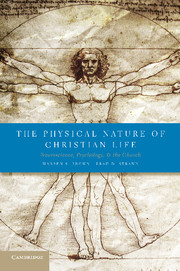Part III - Emodied Christian Life and The Church: Retrospect and Prospect
Published online by Cambridge University Press: 05 July 2012
Summary
REVIEW
In Part II we described the development, formation, and change of persons. Our primary objective was to bring to the forefront those things known to be the case in human neuroscience and psychology that should be kept in mind as we consider the formation of Christian persons from the perspective of an embodied view of human nature.
Chapter 4 focused on children, summarizing important issues in their mental and social development. An important part of this process is the maturation of the physical structure of the brain. Because of the unusual openness and plasticity of the developing human brain, social influences are particularly critical to the direction of the development of personhood. Thus, we described the impact of interpersonal interactions such as imitation, shared attention, attachment, and empathy, as well as the formative nature of language and story.
Equally important for understanding Christian formation are the dynamics of continuing adult personality and character development. Thus, Chapter 5 dealt with adult formation and transformation. Using the descriptive language of dynamical systems, we gave an account of how adults are continually changed and transformed for better or worse as they experience life. We paralleled our summary of child development by describing how formative forces in adults are still almost exclusively interpersonal – including, as with children, imitation, attachments, and life-forming narratives.
- Type
- Chapter
- Information
- The Physical Nature of Christian LifeNeuroscience, Psychology, and the Church, pp. 101 - 104Publisher: Cambridge University PressPrint publication year: 2012



